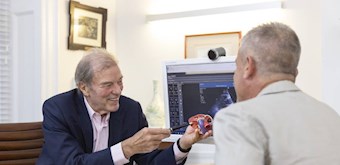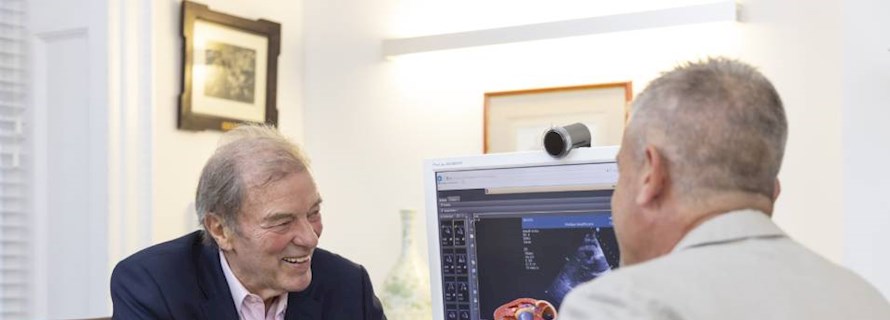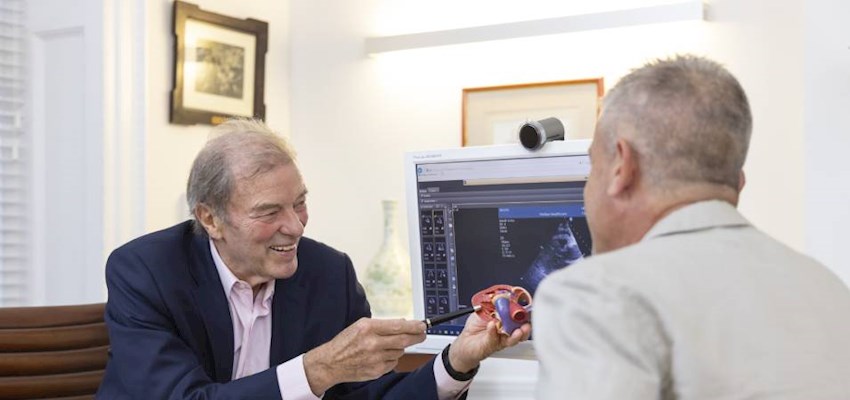Electrical cardioversion
A procedure to restore normal heart rhythm
Cardioversion is used to treat atrial fibrillation, a condition that causes an irregular heart beat
What is electrical cardioversion?
Electrical cardioversion is a treatment which is used to restore a normal heartbeat in people with heart rhythm problems (cardiac arrhythmias).
Symptoms of heart rhythm problems may include:
- A pounding, fluttering feeling in your chest
- Dizziness or fatigue
- Shortness of breath
- Pain or discomfort in your chest
If you think you may have a heart rhythm problem, or have experienced any of these symptoms, then you should make an appointment to see a cardiologist as soon as possible.
Electrical cardioversion is not suitable for everyone, however if you are diagnosed with a heart rhythm problem such as atrial fibrillation, atrial flutter or ventricular tachycardia, your cardiologist may recommend it.
During this treatment, controlled electrical signals are sent to your heart, to try and restore a normal heart rhythm.
Types of cardioversion
There are 2 types of electrical cardioversion: external and internal.
External cardioversion: this is done under general anaesthetic (you will be asleep throughout the process). Electrodes connected to a defibrillator machine are placed on your chest and back. The electrodes administer one or more controlled electric shocks to try and restore your heart rhythm to normal.
Internal cardioversion: this is done under local anaesthetic (you will be awake during the process). A small tube is inserted into a vein at the top of your leg. A fine wire is then passed through this tube and into your heart, to deliver an internal electric shock.
Electrical cardioversion usually only takes around 10-20 minutes to complete, however you will be closely monitored by your cardiologist for several hours afterwards. Depending on how you respond to the treatment, your general health and whether you have any other medical conditions, you may be able to go home the same day. However, in some cases it may be necessary to stay overnight for monitoring.
Electrical cardioversion is an effective treatment for many people living with heart rhythm problems, as it can quickly restore a regular heartbeat. However, some people need additional treatments to maintain a normal heart rate in the future.
Electrical cardioversion complications
Most people do not experience complications from electrical cardioversion, and the risk to your health if you are diagnosed with atrial fibrillation or another heart rhythm problem is usually much greater than the risks associated with this treatment.
Although complications from electrical cardioversion are rare, some people do experience side effects. Common side-effects from electrical cardioversion include:
- Headaches/dizziness (caused by a drop in blood pressure)
- Chest discomfort at the site of the treatment
- Nausea/sickness (from the anaesthetic)
These symptoms are usually temporary.
In rare cases, people experience more serious complications from electrical cardioversion. These include:
Blood clots in the heart: this can be life-threatening if the blood clots dislodge and travel to the lungs or brain, causing a pulmonary embolism or stroke. Your cardiologist may recommend taking blood thinning medication before and after the procedure.
Other heart rhythm problems: in some cases, people develop a different type of heart rhythm problem following electrical cardioversion, although often this can be corrected with medication or further cardioversion treatment.
Damage to the heart: although this is usually temporary, in very rare cases it can lead to heart failure
Minor burns: occasionally, people experience minor burns where the electrodes are placed on their skin. If this occurs, it can be easily treated with cream.
Electrical cardioversion is not suitable for everyone. Your cardiologist will take into account your symptoms, diagnosis, and other risk factors such as your age, weight and other health conditions you may have, before deciding whether it is the best treatment option for you.
For some people, electrical cardioversion is initially successful however their heart rhythm problem returns later. In order to reduce the chances of this happening, your doctor may prescribe medication to take before and after the procedure.
If you do experience complications after your procedure, then don’t worry. Your cardiology team will be on-hand to monitor your progress closely and make sure you receive the care that you need.
Need to know
-
How to prepare icon plus
Your consultant will tell you how to prepare for your electrical cardioversion treatment. It’s important to let us know if you’re taking any medication, as you may need to stop taking it before your procedure. You’ll be asked to stop eating and drinking a few hours beforehand. Like all procedures, there may be some risks and side effects involved. Your consultant will explain these to you and answer any questions you have.
Electrical cardioversion is an effective treatment for people with atrial fibrillation, however If you have had atrial fibrillation for more than 2 days, cardioversion can increase the risk of a clot forming.
If you are having electrical cardioversion to treat atrial fibrillation, you will usually need to take an anticoagulant for 3 to 4 weeks before and after treatment, to reduce the risk of a stroke. -
Electrical cardioversion procedure icon plus
Electrical cardioversion is a painless procedure which is usually carried out on an out-patient basis. This means you’ll be able to go home a few hours later.
There are 2 types of electrical cardioversion, external and internal. Your cardiology team will decide which is the most suitable treatment for you, depending on your diagnosis and other factors including your general health.
External cardioversion: this is the most common type of cardioversion. During this procedure, you will be given a general anaesthetic, which means you will be asleep for the entire process. Whilst you are asleep, electrodes are attached to your chest and back. These electrodes are connected to a defibrillator machine, which is used to administer one or more small, controlled electric shocks to your heart.
Internal cardioversion: this procedure is carried out under local anaesthetic, which means that you will be awake throughout the process. You will be given an injection to numb your groin, and a small tube will be inserted into a vein at the top of your leg. This process will be painless but may be slightly uncomfortable. A fine wire is then passed through this tube, along the vein and into your heart. Using a defibrillator machine, an electrical current is then used to deliver a small electric shock directly to your heart, to try and restore a normal heart rhythm.
Electrical cardioversion is a straightforward, painless procedure which takes around 10 - 20 minutes to complete. Most people are able to return home the same day.
The aim of electrical cardioversion is to restore your heart rhythm to normal. For some people, this may involve more than one treatment. You may also need to take medication afterwards to prevent your heart rhythm problem from returning.
-
Recovery after your cardioversion icon plus
It’s normal to be concerned about how quickly you will recover from heart treatment.
Electrical cardioversion is a simple procedure which quickly restores heart rhythm to normal for most people. If the treatment is successful, you should be able to return to normal life as soon as you feel well enough. Your cardiology team will be on-hand with practical advice about your recovery.
How much does an electrical cardioversion cost?
There are several different options available for paying for electrical cardioversion. In some cases, the procedure is covered by private medical insurance. Speak to your insurer to find out whether you are covered for this treatment, and whether any conditions apply.
You can also choose to pay for your electrical cardioversion privately using your preferred payment method. We will provide you with a clear and transparent quote for the treatment, so that you’re not surprised by any hidden costs or additional charges.
If you would like to find out more about our payment options, then you can telephone us on: 020 3811 7567, or use our online appointment service. We’ll be happy to talk you through the options.

FAQs about an Electrical Cardioversion

How soon can I go home after electrical cardioversion?

Most people are able to go home within a few hours of receiving electrical cardioversion although in some cases, you may need to stay in hospital overnight. Your cardiology team will monitor you closely after the procedure before making a decision about your care.
If you are discharged home, you will need somebody to drive you because you may still be under sedation.

When can I get back to normal life after electrical cardioversion?

If your treatment is successful, you will be able to return to your normal life relatively quickly, however you should rest as much as possible for a few days. If you had an internal electrical cardioversion, you should rest for at least 3-4 days to allow the incision at the top of your thigh to heal.
Your cardiologist will advise you when it is safe to return to normal activities and provide further information about medication, exercise, travel, diet and alcohol.

How soon can I start exercising after electrical cardioversion?

You should avoid strenuous activity following this procedure, particularly if you had an internal electrical cardioversion.
Your cardiologist will let you know when it’s safe to resume exercise and more strenuous activities.

Will I need to take medication following electrical cardioversion?

If your electrical cardioversion treatment is successful, you may not need to take any medication. However, most people will need to take blood-thinning medication both before and after the procedure, to reduce the risk of blood clots forming. If you are at high risk of atrial fibrillation returning, or of having a stroke, then you may need to take medication for longer.

What is the success rate for electrical cardioversion?

This procedure successfully restores normal heart rhythm for most people. You may need to repeat the treatment in the future if your cardiac arrhythmia returns.
Consult a cardiologist about electrical cardioversion
Our renowned cardiologists are experts in electrical cardioversion. They use the latest diagnostic technology and minimally invasive techniques to provide you with the most accurate, thorough diagnosis and treatment options available.
If you are referred for electrical cardioversion, then you can rest assured that you will receive the very highest level of care from our expert cardiology teams.




Private treatment for electrical cardioversion
From complex cardiothoracic surgery to straightforward cardiac tests and procedures, we provide exceptional care across our network of hospitals, outpatient centres and specialist clinics.
Request a cardiac appointment
If heart symptoms are affecting your quality of life, we’re here to help. Our heart team is available to book an appointment with a cardiac specialist.
Call us today
020 7616 4988